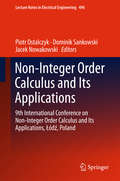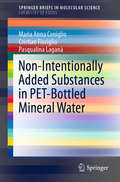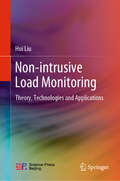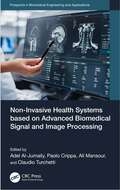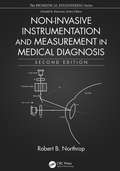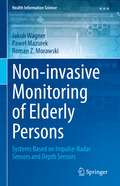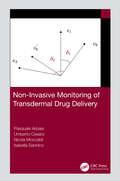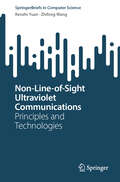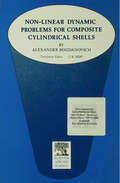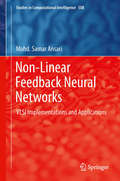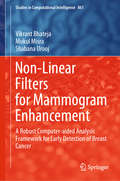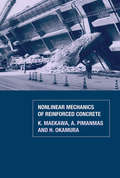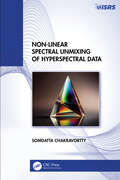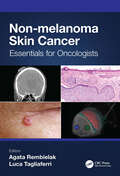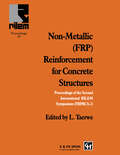- Table View
- List View
Non-Imaging Microwave and Millimetre-Wave Sensors for Concealed Object Detection
by Boris Y. Kapilevich Stuart W. Harmer Nicholas J. BowringIn response to the ever-increasing global threat of terrorist attacks, the personal screening industry has been growing at a rapid rate. Many methods have been developed for detecting concealed weapons and explosives on the human body. In this important new book, the authors discuss their experiences over the last decade designing and testing microwave and millimetre wave detection and screening systems. It includes examples of actual devices that they have built and tested, along with test results that were obtained in realistic scenarios. The book focuses on the development of non-imaging detection systems, which are similar to radar. These systems do not form a conventional image of the scene and the person(s) being screened. Instead, the sensors detect and analyze the effect that the body, and any concealed objects, has on a transmitted waveform. These systems allow remote detection of both metallic and dielectric devices concealed on the human body in both indoor and outdoor environments. The book discusses a number of sensor types, including active millimetre wave sensors using the direct detection and the heterodyne approach, active microwave sensors for CNR-based object detection, passive millimetre wave sensors, and the role of shielding effects in operating non-imaging MM-wave sensors. The goal of this book is to systemize the test results obtained by the authors, helping specialists to develop improved screening systems in the future. Another goal is to show how the use of non-imaging systems can reduce the cost of the screening process.
Non-Integer Order Calculus and its Applications: 9th International Conference On Non-integer Order Calculus And Its Applications, Łódź, Poland (Lecture Notes In Electrical Engineering #496)
by Jacek Nowakowski Dominik Sankowski Piotr OstalczykThis book focuses on fractional calculus, presenting novel advances in both the theory and applications of non-integer order systems. At the end of the twentieth century it was predicted that it would be the calculus of the twenty-first century, and that prophecy is confirmed year after year. Now this mathematical tool is successfully used in a variety of research areas, like engineering (e.g. electrical, mechanical, chemical), dynamical systems modeling, analysis and synthesis (e.g technical, biological, economical) as well as in multidisciplinary areas (e.g. biochemistry, electrochemistry).As well as the mathematical foundations the book concentrates on the technical applications of continuous-time and discrete-time fractional calculus, investigating the identification, analysis and control of electrical circuits and dynamical systems. It also presents the latest results.Although some scientific centers and scientists are skeptical and actively criticize the applicability of fractional calculus, it is worth breaking through the scientific and technological walls. Because the “fractional community” is growing rapidly there is a pressing need for the exchange of scientific results. The book includes papers presented at the 9th International Conference on Non-integer Order Calculus and Its Applications and is divided into three parts:• Mathematical foundations• Fractional systems analysis and synthesis• System modelingSeven papers discuss the mathematical foundations, twelve papers address fractional order analysis and synthesis and three focus on dynamical system modeling by the fractional order differential and difference equations. It is a useful resource for fractional calculus scientific community.
Non-Intentionally Added Substances in PET-Bottled Mineral Water (SpringerBriefs in Molecular Science)
by Maria Anna Coniglio Cristian Fioriglio Pasqualina LaganàThis book discusses a major issue in the food contact materials industry: non-intentionally added substances (NIAS), and their impact on PET-bottled water. NIAS are chemical compounds that are present in food contact materials but have not been added for technical reasons during the production process, and consumers are usually unaware of their presence. NIAS can include decomposition or degradation products, impurities in the raw materials, unwanted by-products or contaminants from recycling processes, and they pose a challenge for packaging manufacturers.In Europe, the EU Regulations No. 1935/2004 and 10/2011 set out, respectively, the general principles of safety and inertness for all packaging materials, and rules on the composition of plastic food-contact materials. Among the plastics commonly used for bottled water and other non-alcoholic refreshment beverages, polyethylene terephthalate (PET) is the most favoured thanks to its chemical and physical stability, its transparency, low weight and good recyclability. Further, very few additives are used for its manufacture. Nonetheless, due to the complex formulations of polymers, processes and storage, NIAS can also be found in PET-bottled water, with potential cancerogenic or toxic effects.This book provides an overview of the European regulation of NIAS in plastic packaging materials, offering insights into their chemical composition in PET-bottled water. Lastly, it provides a useful discussion on NIAS and their toxicity.
Non-intrusive Load Monitoring: Theory, Technologies and Applications
by Hui LiuFocusing on non-intrusive load monitoring techniques in the area of smart grids and smart buildings, this book presents a thorough introduction to related basic principles, while also proposing improvements. As the basis of demand-side energy management, the non-intrusive load monitoring techniques are highly promising in terms of their energy-saving and carbon emission reduction potential.The book is structured clearly and written concisely. It introduces each aspect of these techniques with a number of examples, helping readers to understand and use the corresponding results. It provides latest strengths on the non-intrusive load monitoring techniques for engineers and managers of relevant departments. It also offers extensive information and a source of inspiration for researchers and students, while outlining future research directions.
Non-invasive and Non-destructive Methods for Food Integrity
by Ana María Jiménez-Carvelo Alejandra Arroyo-Cerezo Luis Cuadros-RodríguezThere is an increasing need for the food industry to provide information to ensure quality requirements and prevent the food fraud, applying in-situ and on-line technologies for full process control along the food chain. In today's information age, consumers want to be able to have as much information as possible about products quickly and efficiently. Therefore, the rapid detection of indicators that determine food quality and safety risks helps to ensure an effective and comprehensive food sovereignty system. For this purpose, the most powerful and commonly used analytical techniques are liquid or gas chromatography, both coupled to different detection systems. The use of these analytical techniques involves long analysis times and prior procedures of fitness for measuring such as sample pre-treatment, in which the use of reagents and chemical solvents that may be hazardous or harmful to the environment is common. These facts highlight the need for the development of new analytical methods that offer the possibility of rapid, non-invasive, on-site, environmentally friendly analyses that can be carried out along the entire production chain. In addition, recent technological developments and advances in data mining and machine learning offer the opportunity to introduce changes that could transform the role of food integrity. Non-invasive and Non-destructive Methods for Food Integrity is dedicated to describing the fundamentals and applications of existing analytical technologies and the current state of these techniques at industrial level. The text utilizes reported studies and applications, differentiating by particular food and beverage groups, in order to provide a comprehensive and detailed overview of the current state of the art of non-invasive / non-destructive analytical techniques for food quality and integrity. For each technique covered, an introduction is included and thechemical information obtained and why this technology is useful for food analysis. Information on the instrumentation available for the application of each technique in food is also provided, as well as information on data processing, with reference to the treatment of the signal obtained and the use of chemometrics. Applications published in scientific literature are detailed for different categories of similar foods, based on the techniques that are already used for the routine control of food integrity. This book provides guidance for potential users in the food industries and quality control laboratories for choosing which technology to implement based on the type of product and the results to be obtained.
Non-Invasive Health Systems based on Advanced Biomedical Signal and Image Processing (Prospects in Biomedical Engineering and Applications)
by Adel Al-Jumaily Paolo Crippa Ali Mansour Claudio TurchettiThis book contains up-to-date noninvasive monitoring and diagnosing systems closely developed by a set of scientists, engineers, and physicians. The chapters are the results of different biomedical projects and theoretical studies that were coupled by simulations and real-world data.Non-Invasive Health Systems based on Advanced Biomedical Signal and Image Processing provides a multifaceted view of various biomedical and clinical approaches to health monitoring systems. The authors introduce advanced signal- and image-processing techniques as well as other noninvasive monitoring and diagnostic systems such as inertial sensors in wearable devices and novel algorithm-based hybrid learning systems for biosignal processing. The book includes a discussion of designing electronic circuits and systems for biomedical applications and analyzes several issues related to real-world data and how they relate to health technology including ECG signal monitoring and processing in the operating room. The authors also include detailed discussions of different systems for monitoring various conditions and diseases including sleep apnea, skin cancer, deep vein thrombosis, and prosthesis controls. This book is intended for a wide range of readers including scientists, researchers, physicians, and electronics and biomedical engineers. It will cover the gap between theory and real life applications.
Non-Invasive Instrumentation and Measurement in Medical Diagnosis (Biomedical Engineering)
by Robert B. NorthropNon-Invasive Instrumentation and Measurement in Medical Diagnosis, Second Edition discusses NIMD as a rapidly growing, interdisciplinary field. The contents within this second edition text is derived from Professor Robert B. Northrop’s experience teaching for over 35 years in the Biomedical Engineering Department at the University of Connecticut. The text focusses on the instruments and procedures which are used for non-invasive medical diagnosis and therapy, highlighting why NIMD is the preferred procedure, whenever possible, to avoid the risks and expenses associated with surgically opening the body surface. This second edition also covers a wide spectrum of NIMD topics including: x-ray bone densitometry by the DEXA method; tissue fluorescence spectroscopy; optical interferometric measurement of nanometer tissue displacements; laser Doppler velocimetry; pulse oximetry; and applications of Raman spectroscopy in detecting cancer, to name a few. This book is intended for use in an introductory classroom course on Non-Invasive Medical Instrumentation and Measurements taken by juniors, seniors, and graduate students in Biomedical Engineering. It will also serve as a reference book for medical students and other health professionals intrigued by the topic. Practicing physicians, nurses, physicists, and biophysicists interested in learning state of the art techniques in this critical field will also find this text valuable. Non-Invasive Instrumentation and Measurement in Medical Diagnosis, Second Edition concludes with an expansive index, bibliography, as well as a comprehensive glossary for future reference and reading.
Non-invasive Monitoring of Elderly Persons: Systems Based on Impulse-Radar Sensors and Depth Sensors (Health Information Science)
by Jakub Wagner Paweł Mazurek Roman Z. MorawskiThis book covers the results of a study concerning systems for healthcare-oriented monitoring of elderly persons. It is focused on the methods for processing data from impulse-radar sensors and depth sensors, aimed at localisation of monitored persons and estimation of selected quantities informative from the healthcare point of view. It includes mathematical descriptions of the considered methods, as well as the corresponding algorithms and the results of their testing in a real-world context. Moreover, it explains the motivations for developing healthcare-oriented monitoring systems and specifies the real-world needs which may be addressed by such systems.The healthcare systems, all over the world, are confronted with challenges implied by the ageing of population and the lack of adequate recruitment of healthcare professionals. Those challenges can be met by developing new technologies aimed at improving the quality of life of elderly people and at increasing the efficiency of public health management. Monitoring systems may contribute to this strategy by providing information on the evolving health status of independently-living elderly persons, enabling healthcare personnel to quickly react to dangerous events. Although these facts are generally acknowledged, such systems are not yet being commonly used in healthcare facilities and households. This may be explained by the difficulties related to the development of technological solutions which can be both acceptable for monitored persons and capable of providing healthcare personnel with useful information. The impulse-radar sensors and depth sensors, considered in this book, have a potential for overcoming those difficulties since they are not cumbersome for the monitored persons – if compared to wearable sensors – and do not violate the monitored person's privacy – if compared to video cameras. Since for safety reasons the level of power, emitted by the radar sensors, must be ultra-low, the task of detection and processing of signals is a research challenge which requires more sophisticated methods than those developed for other radar applications. This book contains descriptions of new Bayesian methods, applicable for the localisation of persons by means of impulse-radar sensors, and an exhaustive review of previously published ones. Furthermore, the methods for denoising, regularised numerical differentiation and fusion of data from impulse-radar sensors and depth sensors are systematically reviewed in this book. On top of that, the results of experiments aimed at comparing the performance of various data-processing methods, which may serve as guidelines for related future projects, are presented.
Non-Invasive Monitoring of Transdermal Drug Delivery
by Pasquale Arpaia Umberto Cesaro Nicola Moccaldi Isabella SanninoThe book presents an innovative technology based on injection of a very weak current to trace the quantity of a drug carried immediately after the administration. The book makes the reader familiar with the technology, from the conception through the design of the instrument, up to the preliminary clinical applications. In the first chapter, the method of transdermal drug delivery and the use of impedance spectroscopy in the dermatological field are presented. The second chapter describes a screening measurement campaign aimed at proving the feasibility of the assessment method and identifying the bandwidth of interest. The prototyping, validation and characterization of an instrument to measure the amount of drug delivered (DUSM: Drug Under Skin Meter) are presented in chapter three. In the fourth chapter three experimental campaigns, based on the electrical analysis of the biological tissue behavior due to the drug delivery, are reported: (i) laboratory emulation on eggplants, (ii) ex-vivo tests on pig ears, and finally (iii) in-vivo tests on human volunteers. In the fifth chapter a behavioral model, based on Finite Elements and Partial Differential Equation, of an impedance-based measurement system for assessing the drug released under the skin, during transdermal delivering, is proposed. The last chapter is dedicated to present a campaign in order to prove the suitability for insulin therapy applications. This book is intended for biomedical engineers, biomedical engineering students, operators working in the field of biomedical instrumentation, biotechnologists, and technicians of transdermal vehiculation.
Non-ionizing Radiation Protection: Summary of Research and Policy Options
by Andrew W. Wood Ken KaripidisA comprehensive review of non-ionizing radiation and its public health and environmental risks, for researchers, policy makers, and laymen This book explains the characteristics of all forms of electromagnetic non-ionizing radiation (NIR) and analyzes the relationship between exposure and its biological effects, as well as the known dose-response relationships associated with each. Taking a uniquely holistic approach to the concept of health that builds upon the WHO definition to include not only absence of disease, but the physical, mental and social well-being of individuals and the population, it reviews established and potential risks and protections, along with regulatory issues associated with each. The risks to public health of NIR, whether in the form of UV light, radio waves from wireless devices, or electric and magnetic fields associated with electrical power systems, is currently a cause of great concern among members of the public and lawmakers. But in order to separate established science from speculation and make informed decisions about how to mitigate the risks of NIR and allocate precious resources, policymakers, manufacturers, and individuals need a comprehensive source of up-to-date information based on the current scientific evidence. Written by a team of experts in their fields, this book is that source. Among other things, it: Summarizes scientific findings on the safety of different forms of NIR and the rationale behind current standards Describes devices for monitoring NIR along with the established and potential hazards of each form Explores proper protections against UV light and lasers, RF radiation, ELF fields and other forms of NIR Discusses how to avoid injuries through occupational training or public awareness programs, and how to perform medical assessments in cases of suspected NIR injuries Considers how to decide whether or not to spend money on certain mitigation measures, based on cost-benefit analyses Offering expert reviews and analyses of the latest scientific findings and public policy issues concerning the risks to public health and the environment of NIR, Non-ionizing Radiation Protection is an indispensable source of information for manufacturers, government regulators, and regulatory agencies, as well as researchers, concerned laypersons, and students.
Non-Isolated DC-DC Converters for Renewable Energy Applications
by Frede Blaabjerg Mahajan Sagar Bhaskar Sanjeevikumar PadmanabanPhotovoltaic (PV) energy generation is an excellent example of large-scale electric power generation through various parallel arrangements of small voltage-generating solar cells or modules. However, PV generation systems require power electronic converters system to satisfy the need for real-time applications or to balance the demand for power from electric. Therefore, a DC-DC power converter is a vital constituent in the intermediate conversion stage of PV power. This book presents a comprehensive review of various non-isolated DC-DC power converters. Non-isolated DC-DC converters for renewable energy system (RES) application presented in this book 1st edition through a detailed original investigation, obtained numerical/experimental results, and guided the scope to design new families of converters: DC-DC multistage power converter topologies, Multistage "X-Y converter family", Nx IMBC (Nx Interleaved Multilevel Boost Converter), Cockcroft Walton (CW) Voltage Multiplier-Based Multistage/Multilevel Power Converter (CW-VM-MPC) converter topologies, and Z-source and quasi Z-source. Above solutions are discussed to show how they can achieve the maximum voltage conversion gain ratio by adapting the passive/active component within the circuits. For assessment, we have recommended novel power converters through their functionality and designs, tested and verified by numerical software. Further, the hardware prototype implementation is carried out through a flexible digital processor. Both numerical and experimental results always shown as expected close agreement with primary theoretical hypotheses. This book offers guidelines and recommendation for future development with the DC-DC converters for RES applications based on cost-effective, and reliable solutions.
Non-Line-of-Sight Ultraviolet Communications: Principles and Technologies (SpringerBriefs in Computer Science)
by Renzhi Yuan Zhifeng WangThis book provides a comprehensive review and the latest progress of ultraviolet communications. Optical wireless communications employing electromagnetic waves in optical wavebands as information carriers can achieve higher communication bandwidth compared with radio frequency based wireless communication. However, the good directionality of optical waves degrades its non-line-of-sight transmission ability for avoiding obstacles. The ultraviolet communication employs the ultraviolet light in “solar blind” waveband (200–280 nm) as information carriers. The name “solar blind" is derived from the fact that the solar radiation in 200–280 nm is strongly absorbed by the ozone layer of the atmosphere such that little ultraviolet lights can reach the earth's surface. Therefore, ultraviolet communications enjoy low background radiation noise compared with other optical wireless communications. Besides, the strong absorption effect of ultraviolet lights in the atmosphere also guarantees a good local security due to the verified low-probability-of-detection. Therefore, the ultraviolet communication becomes a promising non-line-of-sight optical wireless communication technology and attracted increasing research attentions in recent decades. This book mainly focuses on the key principles and technologies of ultraviolet communications, including the channel modeling, achievable information rate, full-duplex ultraviolet communication, relay-assisted ultraviolet communication, non-line-of-sight ultraviolet positioning, and some future prospects of ultraviolet communications.
Non-Linear Differential Equations and Dynamical Systems (Mathematics and Physics for Science and Technology)
by Luis Manuel Braga da Costa CamposNon-Linear Differential Equations and Dynamical Systems is the second book within Ordinary Differential Equations with Applications to Trajectories and Vibrations, Six-volume Set. As a set, they are the fourth volume in the series Mathematics and Physics Applied to Science and Technology. This second book consists of two chapters (chapters 3 and 4 of the set). The first chapter considers non-linear differential equations of first order, including variable coefficients. A first-order differential equation is equivalent to a first-order differential in two variables. The differentials of order higher than the first and with more than two variables are also considered. The applications include the representation of vector fields by potentials. The second chapter in the book starts with linear oscillators with coefficients varying with time, including parametric resonance. It proceeds to non-linear oscillators including non-linear resonance, amplitude jumps, and hysteresis. The non-linear restoring and friction forces also apply to electromechanical dynamos. These are examples of dynamical systems with bifurcations that may lead to chaotic motions. Presents general first-order differential equations including non-linear like the Ricatti equation Discusses differentials of the first or higher order in two or more variables Includes discretization of differential equations as finite difference equations Describes parametric resonance of linear time dependent oscillators specified by the Mathieu functions and other methods Examines non-linear oscillations and damping of dynamical systems including bifurcations and chaotic motions
Non-Linear Dynamic Problems for Composite Cylindrical Shells
by Alexander BogdanovichThis monograph will be valuable for English-speaking scientists wanting to know more about the state-of-the-art in Russian research on non-linear shell theory. It will also be of value to all materials scientists concerned with the use and behaviour of composite materials in structural applications.
Non-Linear Elastic Deformations
by R. W. OgdenThis classic offers a meticulous account of the theory of finite elasticity. It covers the application of the theory to the solution of boundary-value problems, as well as the analysis of the mechanical properties of solid materials capable of large elastic deformations. Setting is purely isothermal. Problems. References. Appendixes.
Non-Linear Feedback Neural Networks: VLSI Implementations and Applications
by Mohd. Samar AnsariThis book aims to present a viable alternative to the Hopfield Neural Network (HNN) model for analog computation. It is well known the standard HNN suffers from problems of convergence to local minima, and requirement of a large number of neurons and synaptic weights. Therefore, improved solutions are needed. The non-linear synapse neural network (NoSyNN) is one such possibility and is discussed in detail in this book. This book also discusses the applications in computationally intensive tasks like graph coloring, ranking, and linear as well as quadratic programming. The material in the book is useful to students, researchers and academician working in the area of analog computation.
Non-Linear Filters for Mammogram Enhancement: A Robust Computer-aided Analysis Framework for Early Detection of Breast Cancer (Studies in Computational Intelligence #861)
by Vikrant Bhateja Mukul Misra Shabana UroojThis book presents non-linear image enhancement approaches to mammograms as a robust computer-aided analysis solution for the early detection of breast cancer, and provides a compendium of non-linear mammogram enhancement approaches: from the fundamentals to research challenges, practical implementations, validation, and advances in applications.The book includes a comprehensive discussion on breast cancer, mammography, breast anomalies, and computer-aided analysis of mammograms. It also addresses fundamental concepts of mammogram enhancement and associated challenges, and features a detailed review of various state-of-the-art approaches to the enhancement of mammographic images and emerging research gaps. Given its scope, the book offers a valuable asset for radiologists and medical experts (oncologists), as mammogram visualization can enhance the precision of their diagnostic analyses; and for researchers and engineers, as the analysis of non-linear filters is one of the most challenging research domains in image processing.
Non-Linear Finite Element Analysis in Structural Mechanics
by Wilhelm RustThis monograph describes the numerical analysis of non-linearities in structural mechanics, i. e. large rotations, large strain (geometric non-linearities), non-linear material behaviour, in particular elasto-plasticity as well as time-dependent behaviour, and contact. Based on that, the book treats stability problems and limit-load analyses, as well as non-linear equations of a large number of variables. Moreover, the author presents a wide range of problem sets and their solutions. The target audience primarily comprises advanced undergraduate and graduate students of mechanical and civil engineering, but the book may also be beneficial for practising engineers in industry.
Non-Linear Mechanics of Reinforced Concrete
by K. Maekawa H. Okamura A. PimanmasThis book describes the application of nonlinear static and dynamic analysis for the design, maintenance and seismic strengthening of reinforced concrete structures. The latest structural and RC constitutive modelling techniques are described in detail, with particular attention given to multi-dimensional cracking and damage assessment, and their p
Non-Linear Programming: A Basic Introduction (Mathematical Engineering, Manufacturing, and Management Sciences)
by Nita H. Shah Poonam Prakash MishraThis book is for beginners who are struggling to understand and optimize non-linear problems. The content will help readers gain an understanding and learn how to formulate real-world problems and will also give insight to many researchers for their future prospects. It proposes a mind map for conceptual understanding and includes sufficient solved examples for reader comprehension. The theory is explained in a lucid way. The variety of examples are framed to raise the thinking level of the reader and the formulation of real-world problems are included in the last chapter along with applications. The book is self-explanatory, well synchronized and written for undergraduate, post graduate and research scholars.
Non-Linear Spectral Unmixing of Hyperspectral Data
by Somdatta ChakravorttyThis book is based on satellite image processing, focusing on the potential of hyperspectral image processing (HIP) research with a case study-based approach. It covers the background, objectives, and practical issues related to HIP and substantiates the needs and potentials of said technology for discrimination of pure and mixed endmembers in pixels, including unsupervised target detection algorithms for extraction of unknown spectra of pure pixels. It includes application of machine learning and deep learning models on hyperspectral data and its role in spatial big data analytics.Features include the following: Focuses on capability of hyperspectral data in characterization of linear and non-linear interactions of a natural forest biome. Illustrates modeling the ecodynamics of mangrove habitats in the coastal ecosystem. Discusses adoption of appropriate technique for handling spatial data (with coarse resolution). Covers machine learning and deep learning models for classification. Implements non-linear spectral unmixing for identifying fractional abundance of diverse mangrove species of coastal Sundarbans. This book is aimed at researchers and graduate students in digital image processing, big data, and spatial informatics.
Non-Linearities in Passive RFID Systems: Third Harmonic Concept and Applications
by Gianfranco Andia Yvan Duroc Smail TedjiniThis book concerns a new paradigm in the field of UHF RFID systems: the positive exploitation of nonlinear signals generated by the chips integrated into the RFID tags. After having recalled the main principles in RFID technology and its current challenges notably with the emergence of Internet of Things or the smart connected environments, the purpose is to focus on the presence of nonlinearities produced by the nonlinear circuits of RFID chips: effects, nuisances and solutions but also and especially use of the phenomena. The presentation covers all aspects from the characterization of the nonlinear behavior of RFID tags and the associated platforms (distinguishing conducted and radiated measurement) to the design of new types of tags where nonlinearities are exploited in order to offer new capabilities or enhanced performance.
Non-local Structural Mechanics
by Michael Mccarthy Sondipon Adhikari Danilo Karlicic Tony MurmuServing as a review on non-local mechanics, this book provides an introduction to non-local elasticity theory for static, dynamic and stability analysis in a wide range of nanostructures. The authors draw on their own research experience to present fundamental and complex theories that are relevant across a wide range of nanomechanical systems, from the fundamentals of non-local mechanics to the latest research applications.
Non-melanoma Skin Cancer: Essentials for Oncologists
by Agata Rembielak and Luca TagliaferriThis book provides a comprehensive introduction to the current state-of-the-art in skin cancer, exploring the recent developments, appraising the current evidence and providing future directions with particular emphasis on interdisciplinary collaboration and need for clinical trials. It covers all aspects of skin cancers, including epidemiology, pathology, surgical and non-surgical treatments. It will be a valuable reference for oncologists, dermatologists, dermatopathologists, surgeons, allied health care professionals and other specialists and trainees with a special interest in skin cancer who want to update their knowledge in the multidisciplinary management of such patients. The book will be of interest to medical physicists and radiographers who would like an overview of the current practice in skin cancer. The book can be used by students in medicine, nursing, radiography and medical physics. Features Provides a comprehensive review of all aspects of skin cancer management. Edited by experts in the area, with interdisciplinary and international collaborators. Promotes a 'Bigger picture' approach to the topic with multidisciplinary insight.
Non-Metallic (FRP) Reinforcement for Concrete Structures: Proceedings of the Second International RILEM Symposium
by L. TaerweDealing with a wide range of non-metallic materials, this book opens up possibilities of lighter, more durable structures. With contributions from leading international researchers and design engineers, it provides a complete overview of current knowledge on the subject.

